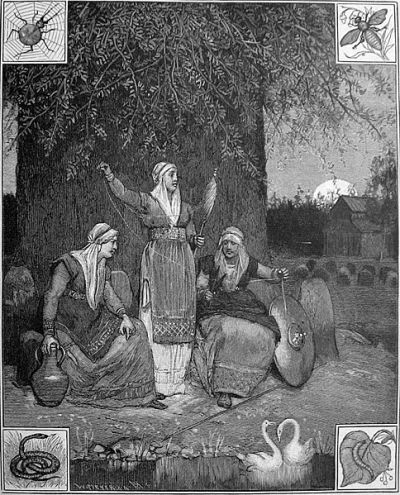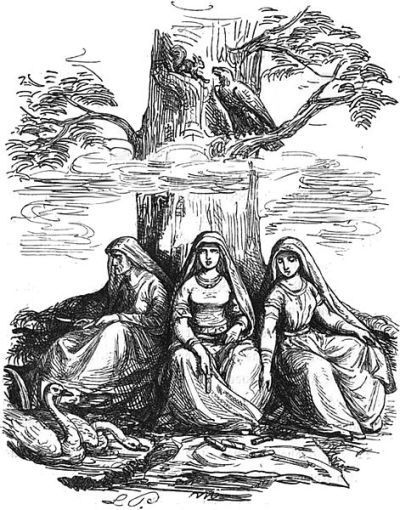Urdarbrunnr is one of the three wells that sustain Yggdrasil, the world tree at the heart of Norse cosmology. Named after Urd, one of the three Norns who shape the destinies of gods and men. This well is a cornerstone of ancient Norse beliefs, imbued with wisdom and the mysteries of fate.
As a crucial element of the mythological landscape, Urdarbrunnr serves not only as a physical entity but also as a symbol of the interconnectedness of life and the universe. It is here that the Norns draw water to nourish the branches of Yggdrasil, ensuring the tree’s vitality spans across the nine worlds.
Urdarbrunnr Key Facts
| Location | Beneath the Yggdrasil in Asgard |
| Known for | Source of wisdom and fate |
| Inhabitants | The Norns (Urd, Verdandi, and Skuld) |
| Other names | Well of Urd, Well of Destiny |
| Old Norse | Urðarbrunnr |
| Associated with | The Norns, Yggdrasil |
Name and Etymology
The Old Norse name ‘Urðarbrunnr’ is a simple combination of two words. It combines ‘Urðr’, the name of the Norn associated with fate, with ‘brunnr’, meaning well or spring. This well is thus intrinsically linked to the concept of fate and the foundational elements of the universe.
The Norn ‘Urðr’, usually Anglicized as Urd, was, as I said, associated with fate. Moreover, her name actually means fate, or as it was known in the old days, wyrd in English. This is part of the origin of the more modern concept of the ‘Web of Wyrd’. The web, woven by the Norns, predetermines all beings’ fate and future.
The well has a strong connection with the Norn Urd, as well as the concept of fate. It has made the ‘Well of Urd”, or the “Well of Fate/Destiny” central to some core beliefs in Norse mythology..
The Origins of Urdarbrunnr
Like the cosmic Tree of Life Yggdrasil itself, little is known about where Urdarbrunnr actually came from. The origins of the well Hvergelmir on the other hand is slightly more clear. It seems to always have been part of the primordial realm Niflheim.
Urdarbrunnr, and Mimisbrunnr for that matter, might have formed naturally at some time in the infancy of the cosmos. After the gods had created Midgard, and the rivers from the Élivágar flowed through it and the other realms, these wells might have come to be.
We know that it is one of the wells that the three roots of Yggdrasil draws from, and as such, maybe the well is older than the tree itself. Either way, the Well of Urd is intrinsically connected to the great ash Yggdrasil.
The Norns at the Well of Urd
The well is important in that it provides the great cosmic tree with nourishing water. However, it serves an even more important role as the place where the three Norns live.
The Norns are three ancient jötnar, elevated somehow to other beings, who decide the fate of all men. Depending on the source, they either weave these fates, or carve them as runes into the roots of the Yggdrasil.
,Urd (Old Norse Urðr) is the namesake of the well. She embodies the concept of ‘fate’ or ‘what has passed’. She is depicted as a crone, always gazing backward, symbolizing her focus on the past. Her presence is often seen as benign, offering insights into the significance of past events and actions.

Verdandi, (Old Norse Verðandi) represents ‘what is passing into being’. She is portrayed as young, strong, and determined, her gaze fixed straight ahead, symbolizing her role in assessing current actions. She is often associated with guiding decisions in the present moment. Skuld (same in Old Norse), on the other hand, signifies ‘what shall come to pass’ and is viewed as the least benign of the three. While her sisters weave destinies, Skuld is known for disrupting their creations, often leading to confusion and unpredictability in the lives of mortals.
There are more Norns, their number is largely unknown, but the three living by the Well of Urd are the ones deciding on the fate of all beings.
The Norns care for the great tree
The three Norns living by the Urdarbrunnr also work to care for Yggdrasil. This is described in Snorris Gylfaginning:
“Again, it is said that the norns, that dwell in the fountain of Urd, every day take water from the fountain and take the clay that lies around the fountain and sprinkle therewith the ash, in order that its branches may not wither or decay. This water is so holy that all things that are put into the fountain become as white as the film of an egg-shell”
This also explains how this ‘holy water’ likely is part of what gives Yggdrasil its extraordinary powers.
Meeting place of the gods

The significance of Urdarbrunnr lies not just in its role as the Norns well, but also as a meeting place for the gods. In fact they travel there everyday to meet and discuss important matters. While most of the gods ride across the Bifrost bridge to get there, Thor instead wades across some rivers. It is not quite clear why he doesn’t also ride across the bridge. One possible reason might have to do with the thunder and lightning that his goat drawn chariot might be creating.
I’ll go into the location of the well next, but I want to highlight that the place the gods meet is called their doomstead. In Old Norse it is ‘dómsins’ which can be translated as a place of judgment. As they go there every day, it seems to imply that it’s actually quite central in how the gods govern both Asgard as well as the nine realms.
Location of Urdarbrunnr
As for its actual location it is divulged in Gylfaginning, at least partially. It is said that Urdarbrunnr is under the third root of Yggdrasil, which is the root that stretches all the way to Asgard. However, there are two points which more or less firmly place it outside of Asgard, most likely in Midgard.
The paragraph goes like this:
“The third root of the ash is in heaven, and beneath it is the most sacred fountain of Urd. Here the gods have their doomstead. The Aesir ride hither every day over Bifrost, which is also called Aesir-bridge.”
So, to get there, the gods ride across the Bifrost bridge, which usually is understood as leading to Midgard. Also, it is “under” the third root, which also points to Midgard as Asgard is understood as being in the heavens, above Midgard.
Worth noting here is also that Thor is said to wade across three or four rivers to get to the well for the gods’ daily meeting. This would support the notion that the location of the well is outside of Asgard as rivers are also often understood to be boundaries between realms.
Outside or Inside Asgard?
Then, in typical Norse myth fashion, the next clues are somewhat contradictory to this assertion. Only a few paragraphs later this paragraph throws the above argument somewhat to the side.
“Many fair places there are in heaven, and they are all protected by a divine defense. There stands a beautiful hall near the fountain beneath the ash. Out of it come three maids, whose names are Urd, Verdande and Skuld.”
This passage seems to place the well as one of the “many fair places there are in heaven” which are all protected by a divine fence, the ‘-gard’. With few other clues as to where the well is located, I believe it is in Midgard. However, it could be in some half-way place between Midgard and Asgard.
Description and Characteristics
The Urdarbrunnr, a place of mystery and power, is more than just a location in Norse mythology; it’s a character in its own right, with a personality that is both nurturing and foreboding.

Nestled close to, and under the green leaves of Yggdrasil, the immense ash tree that connects the nine worlds, Urdarbrunnr seems to be a serene place.This is in great contrast to the well Hvergelmir, deep in Niflheim, inhabited by unknown numbers of venomous serpents.
In the Well of Urd however, two great swans live, the ancestors of the whole race of swans. This is further described in the Gylfaginning:
“The dew which falls on the earth from this tree men call honey-fall, and it is the food of bees. Two birds are fed in Urd’s fountain; they are called swans, and they are the parents of the race of swans.”
Mentions in Ancient Texts
Poetic Edda
“Völuspá”

In “Völuspá”, a key poem of the Poetic Edda, Urðarbrunnr is depicted beneath Yggdrasil. Stanzas 19 and 20 describe the well, covered in white mud, from which the Norns – Urðr, Verðandi, and Skuld – emerge to set laws and determine fates. The well’s connection to Yggdrasil and the Norns highlights its central role in Norse cosmology.
“Hávamál”
“Hávamál”, another significant poem, includes a mysterious reference to Urðarbrunnr in stanza 111. The verse, “Time ’tis to discourse from the preacher’s chair. By the well of Urd I silent sat, I saw and meditated, I listened to men’s words,” suggests contemplation and wisdom associated with the well.
Prose Edda
Gylfaginning

In “Gylfaginning” of the Prose Edda, Urðarbrunnr is extensively mentioned. The well is described as holy, located beneath Yggdrasil’s third root among the Æsir. The gods’ daily gatherings at the well and the Norns’ role in sustaining Yggdrasil with its waters underline the well’s sacredness and its integral role in the divine order.
Skáldskaparmál
“Skáldskaparmál” references Urðarbrunnr in two sections. One includes a fragment from Kormákr Ögmundarson, using the well in a kenning for a sword. Another mention juxtaposes Christian and Norse elements, with Christ’s throne said to be south of Urðarbrunnr, illustrating the blending of religious beliefs.
Frequently Asked Questions
The Norns, three powerful female figures representing past, present, and future, are the caretakers of Urdarbrunnr.
The well is intimately connected to Yggdrasil, with its waters nourishing the world tree’s roots.
Urdarbrunnr symbolizes knowledge, destiny, and the interconnectedness of all things in Norse cosmology.
Yes, Urdarbrunnr has been depicted in various forms of art, from ancient runestones to modern paintings.
Featured Image Credit: Lorenz Frølich, Public domain, via Wikimedia Commons
